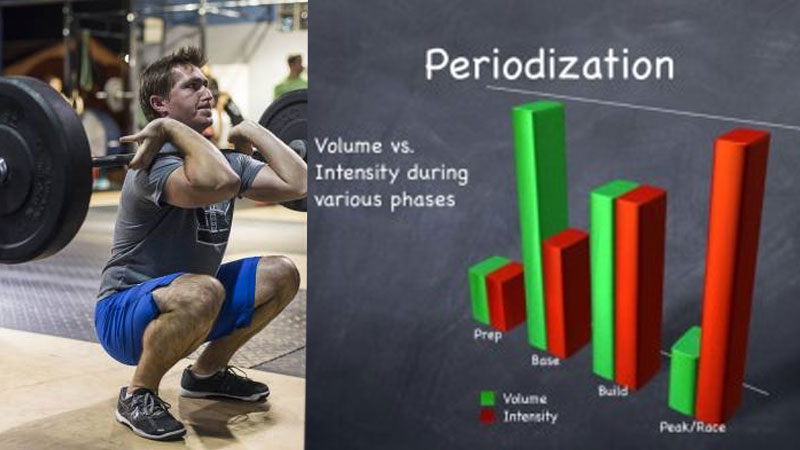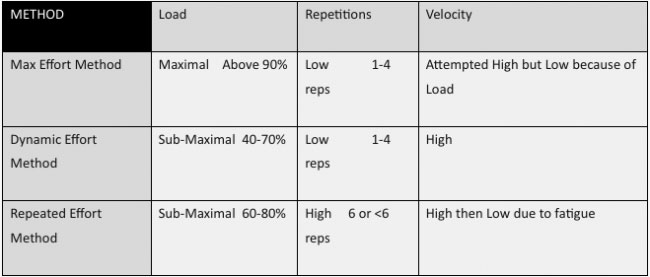
Could conjugate method periodization be the answer to your performance needs? If you’re here to get strong, powerful and ripped to shreds then the answer is a firm and vascular yes.
Meaning ‘come together’, conjugate refers to a type of periodization that came out of Soviet athletics in the 50s. It was then made popular by in the US by super-gym Westside Barbell many years later.
Conjugate periodization is designed to work simultaneous goals such as strength and speed, and builds on the limitations from block methods such as linear periodization.
It’s complicated and definitely takes a while to get your head around.
But it’s worth it just to see the awesome results it provides.
If you’ve not heard of conjugated periodization and want to know how this advanced programming technique can boost your strength, muscle mass and athletic performance, read on…
Periodization Basics
There are two types of bros. The ones that plod along, winging their workout and looking scrawny as sh*t as they struggle to plan an effective program.
And then there’re ones that seem to have it all worked out. Their strength and mass equals their obvious understanding of how to train effectively.
You’ll catch these guys with a note pad and pen nestled sweetly under their bench as they rip the lid off yet another 300 lb press.
Where does periodization fit into the mix?
Periodization itself can be pretty confusing.
At face value it looks like loads of numbers on a spreadsheet – basically the product of gains and mathematics.
But at the heart of it all is a systematic approach to training that boosts results, keeps you on track and gets you straight jacked bro.
There are loads of different ways to follow a periodized program:
- Linear and block
- Weekly and daily undulating
- Reverse
- Sequential and concurrent
While these all find different ways to arrange load, volume and frequency of training, they all have the common goal of improving fitness, strength, endurance and in some cases muscle mass.
And of course conjugate method periodization…
The Conjugate Periodization Method
Not all periodization models are forged from the same iron.
And when it comes to the conjugate method of periodization, you open up the doors to a number of potential benefits:
- Speed and agility
- Explosive power
- Maximal strength
- Huge slabs of muscle mass
It was first used in the 60s and 70s as part of the Soviet system referred to back then as the coupled sequence system.
Many years later, Westside Barbell made the method popular in the west. It put it on the map as part of Louie Simmons’ Westside-Barbell Conjugate Method, which took elements from the original Soviet system and added its own special sauce of knowledge and experience to the mix.
It’s worth noting though that while the Westside method is in itself a conjugate periodization method, it’s not the only one.
There are literally loads of different interpretations used up, down and around the strength gyms of the world.
Conjugate periodization isn’t a set program
The conjugate periodization method differs slightly from the simpler, more linear models that rely on progressive blocks of training.
But it’s still used primarily to make you stronger, faster and leaner.
Unlike block periodization systems where each phase of training is mapped out for you, the conjugate method is a versatile framework, used to guide your training.
Some days you’ll go heavy and hard. Others you’ll go in light and vascular as f*ck as you target blood-pumping volume.
Conjugate method periodization focuses on ever-evolving changes to exercises that focus solely on improving athletic performance. It’s a skeleton framework that you use to build huge, freaking slabs of muscle and brutal. With jacked strength around it.
This method of training is about applying programming variables around you as a person, rather than working on a specific phase or percentage of rep max just because a template says you have to.
Conjugate method periodization is about as far from a ‘cookie cutter’ program as you’ll find.
Okay, how’s conjugate periodization actually work?
The problem with linear periodization is that once you finish a phase of training (for example strength) you don’t revisit it for some time. That means you’ll gradually lose the progress you built up previously.
In other words, if you don’t use it, you lose it.
The conjugate periodization system allows you to train multiple fitness characteristics over the course of the program, making it superior for sports.
In one given week you’ll be covering all of the phases of a linear model.
And to achieve this, conjugate periodization is built around 3 main aspects of strength development:
- Maximal effort
- Repeated effort
- Dynamic effort
It’s the golden chalice of athletic programming.

Conjugate method periodization builds strength, athleticism and muscle mass
Conjugate systems help you avoid staleness, burnout and also optimize recovery because they don’t focus on one single factor of overload.
They marry up things like speed and power, strength and hypertrophy in one huge orgy of gains.
The max effort phase
During this training cycle, you target high intensity, low volume workouts to ramp up maximal strength output.
The idea is just to get all kinds of jailhouse strong.
You’ll work within your 1-4 rep max and prime your nervous system to improve one of your big lifts in each workout – usually either the deadlift, bench and squat.
There are different ways to go about it, but a standard approach is to warm up and then work up to your 1 rep max with sets of 3 reps, until the bar feels heavy.
At that point you then drop down to singles before attempting a final max lift.
Bench press example:
- Set 1 – 8-12 reps @ 150 lbs
- Set 2 – 3-5 reps @ 200 lbs
- Set 3 – 3 reps @ 220 lbs
- Set 4 – 1 rep @ 230 lbs
- Set 5 – 1 rep @ 235 lbs
You’d follow this system each day. For example on Monday you’d do bench, Wednesday could be deadlift and Friday will be all about the squat.
Or you could hit it twice per week and cover deadlift and squat in the same workout.
Repeated effort
In this phase you’re going in hard with a polar opposite approach to max effort.
The aim of the game is to ramp up volume to within an inch of your life, while keeping the load fairly low to moderate.
In this ‘bodybuilding’ phase you’re going in strong on the muscle hypertrophy. By hitting huge volume with moderate loads you’re triggering muscle growth with not only big lifts, but a full arsenal of accessory exercises too (bicep curls, leg extension, triceps kickbacks and so on).
There’s nothing fancy about this phase.
But if you’re the kind of guy that likes to work through set after set of lactate building, acid-scolding, heavy-ass volume work then we applaud you.
And if you’re not that kind of guy?… You should be ashamed of yourself. Hand in your bro card right away you punk.
Repeated effort example:
- Dumbbell incline bench press – 8-12 reps @75% 1RM
- Chest flyes – 8-12 reps @75% 1RM
- Cable crossovers – 8-12 reps @75% 1RM
- Dumbbell skull crusher – 8-12 reps @75% 1RM
- Triceps rope extension – 8-12 reps @75% 1RM
3-5 sets per exercise on all of the above.
Dynamic effort
In the third and final phase you’re pulling it all together with some superhuman speed work.
Dynamic effort training is all about lifting lighter weights with as much velocity and power as possible.
Think The Flash or Quicksilver repping out at full speed.
You can still focus on the big lifts, but the primary thing here is to lift the load at top speed throughout the set. It’s this effect that’s most important.
Where possible you’d throw in your dynamic effort days around 3 days or so after a max lift. So if your max effort bench day was Monday, your dynamic effort day would be Thursday.
Dynamic effort bench press example:
- Set 1 – 6 reps @ 140 lbs
- Set 2- 5 reps @ 150 lbs
- Set 3 – 4 reps @ 160lbs
- Set 4 – 3 reps @ 170 lbs
- Set 5 – 2 reps @ 185 lbs

Summary – Using weekly periodization and putting it all together
Conjugate method periodization originated in Soviet programming, but was made popular in the US by Westside barbell.
It involves layering strength, muscle mass and power training into one solid week of hard training, which is then repeated for a cycle length.
Because there’s no one way of putting the overall program together, you’ve got free reign to adapt the workouts to plan your own individual needs.
You can play around with the conjugate method of periodization based around how many days you have available too, which helps to keep it individual to you.
Here’s a standard schedule that we’ve used in the past…
- Monday – Max effort lower body
- Wednesday – Max effort upper body
- Friday – Dynamic effort lower body
- Sunday – Dynamic effort upper body
(Repeated effort days can be placed intermittently around this core schedule to suit).







I need advice on with designing a safe effective conjugate method workout routine. To optimize strength without overtraining.
I also need advice on how I should alternate doing heavy squat and deadliest max effort. Do squat one week and deadlify the next?
Thank you for your help. I look forward to getting stronger.